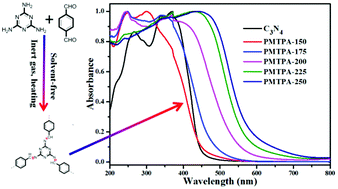A sustainable method toward melamine-based conjugated polymer semiconductors for efficient photocatalytic hydrogen production under visible light†
Abstract
The search for conjugated polymer photocatalysts for H2 production under visible light remains a key challenge. Reported herein is a conjugated polymer (i.e., melamine-terephthalaldehyde polymer (PMTPA)) derived from melamine and terephthalaldehyde precursors without an external solvent through a Schiff-base reaction. By adjusting the polymerization temperature, PMTPA with different sample colors and band gaps was obtained, which was further applied as a photocatalyst to investigate its activity in H2 evolution. A photocatalytic H2 evolution efficiency up to 58.1 μmol h−1 was observed over PMTPA polymerized at 250 °C under visible light (λ > 420 nm), which was about two times as high as that of C3N4. The Schiff-base reaction without external solvent conditions provides a facile strategy for the synthesis of conjugated polymeric semiconductors with better molecular engineering for advanced applications in the fields of catalysis, energy, and environmental remediation.



 Please wait while we load your content...
Please wait while we load your content...